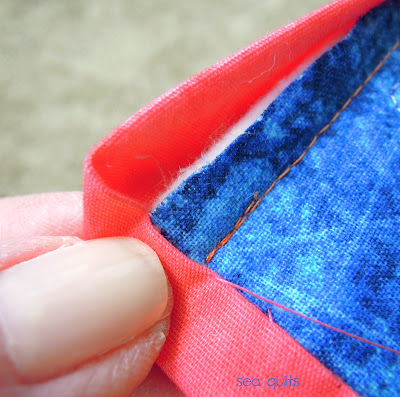 If you missed out on Part One ... Click here. Then be sure to come back!
If you missed out on Part One ... Click here. Then be sure to come back!
Wow!! I had some wonderful response from my last post (thanks to all those who "pinned" me) and I'm all excited about this next part ... which is the part that a LOT of quilters have not yet caught on to. This is the part where you connect the last two ends into one continuous ...
seamed ... piece. No bumps, no folding under, no "jerry-rigging". Just one last seam that is exactly like all the other seams in the binding.
True story.

The first and most important thing you will do at this point is to position the quilt exactly as you see it in the picture above. The edge that you will be working with is facing AWAY from you, and everything you do in preparation before you actually sew the seam, must be don't from this angle.
Do NOT ask me why.
Just Do It.

The next thing you will do is cut a small piece from the right had flap. (The only exception to this is if you have barely enough extra to join the edges, in which case you can just keep in mind the width that you cut your binding pieces, e.g. 2 1/4".)
If you did cut that piece off the right, then keep it right there as a measuring device.

Take the flap on the left and fold it back over itself. That fold should
not quite touch the other flap. The idea is that if you pushed that left fold (assuming you were the sewing machine foot) then it would
barely touch the other side. What that amounts to is about 1/8" (tops) in between.

Now take that little scrap of binding that you cut off and place the right edge on the edge of that folded piece. Draw a line along that left edge and then cut THE TOP FLAP OF THE FOLD on that line. Please don't cut both flaps or you will have a small, ugly fit.

You can see here how the folded back flap is the same measurement as the width of the binding piece.

Now (being careful not to twist anything) you will take the left flap and open it up with the right side facing UP and place the right flap (right side facing DOWN) so that the edges meet as shown. Because both flaps are seriously attached to the rest of the quilt ...
they will want to resist this union. You will need to pin them as securely as possible.

The seam that you will be sewing will go from the left side (where the blue pin-head is) to the right side (where the yellow pin-head is.) As easy as it would be to sew it in the other direction, that is just not going to work, trust me.

Draw a line (on the wrong side of that top flap) from where the left corner of the top flap is to the right corner of the bottom flap. This is exactly what you did when you joined the rest of the pieces before we started this whole process, although this time the edges must meet up exactly.

Now you must take this piece and put it under your foot to sew the seam. More than likely you will need to pull out some stitches on one or both sides to make it possible to maneuver under your foot. This step is easier with a bigger quilt, that is why you are working from the longer side, if possible.
Hint: This little seam does NOT require a Walking Foot, so if you are more comfortable with a regular foot, go ahead and use it. Just make sure to change back to the Walking Foot to sew the final stretch.

After sewing this final juncture, but before you trim the seam to 1/4", pull it out lengthwise to make sure nothing has twisted. Your odds are good if you did indeed position the flaps away from you as in the first step. For whatever reason, this helps prevent twisting.

At this point, go ahead and trim the corner off that seam, leaving 1/4". As best as you can, press the seam open and then re-press the crease in the binding.

Align the raw edge to the raw edge, just as you have all along. Give it another good steam pressing and then go ahead and use a couple of pins. Your binding will lay flat without any excess if you have followed the directions.

Now ...
with your Walking Foot on ... start sewing about a short distance before the stitching ended and continue that same 1/4" seam down until you meet the stitchin on the other end and keep sewing for a short distance to secure the stitches.
Voila! Continuous, non bumpy, fabulous binding.
True story.
Now you are at the point where you will cut off the excess edge of backing and batting.
Do this very carefully with the quilt layed out in front of you so you only cut what you are supposed to! Keep the corners a crisp 90 degrees and be careful not to cut into the flap of the folded over tent. Do not cut
into your 1/4" seam.
Excellent Job!!
Stay tuned for Part Three where I will demonstrate the handsewing on the back, particularly on those lovely square corners.
Thanks for your support. Oooh ... and thank you, Pinterest!





















































